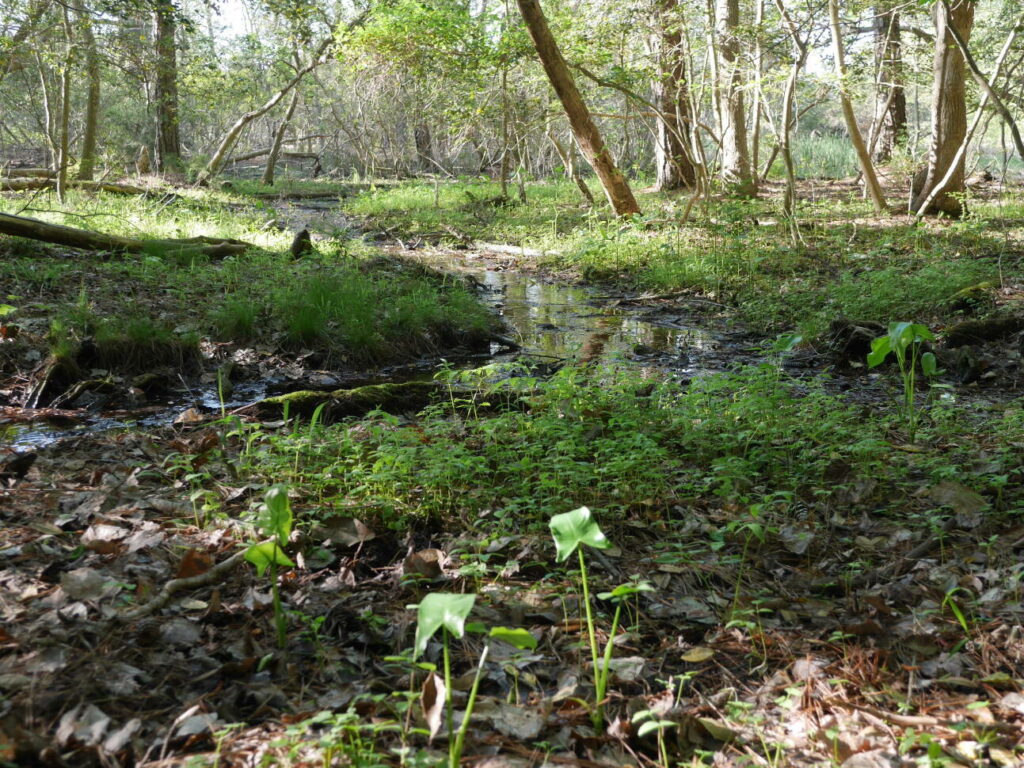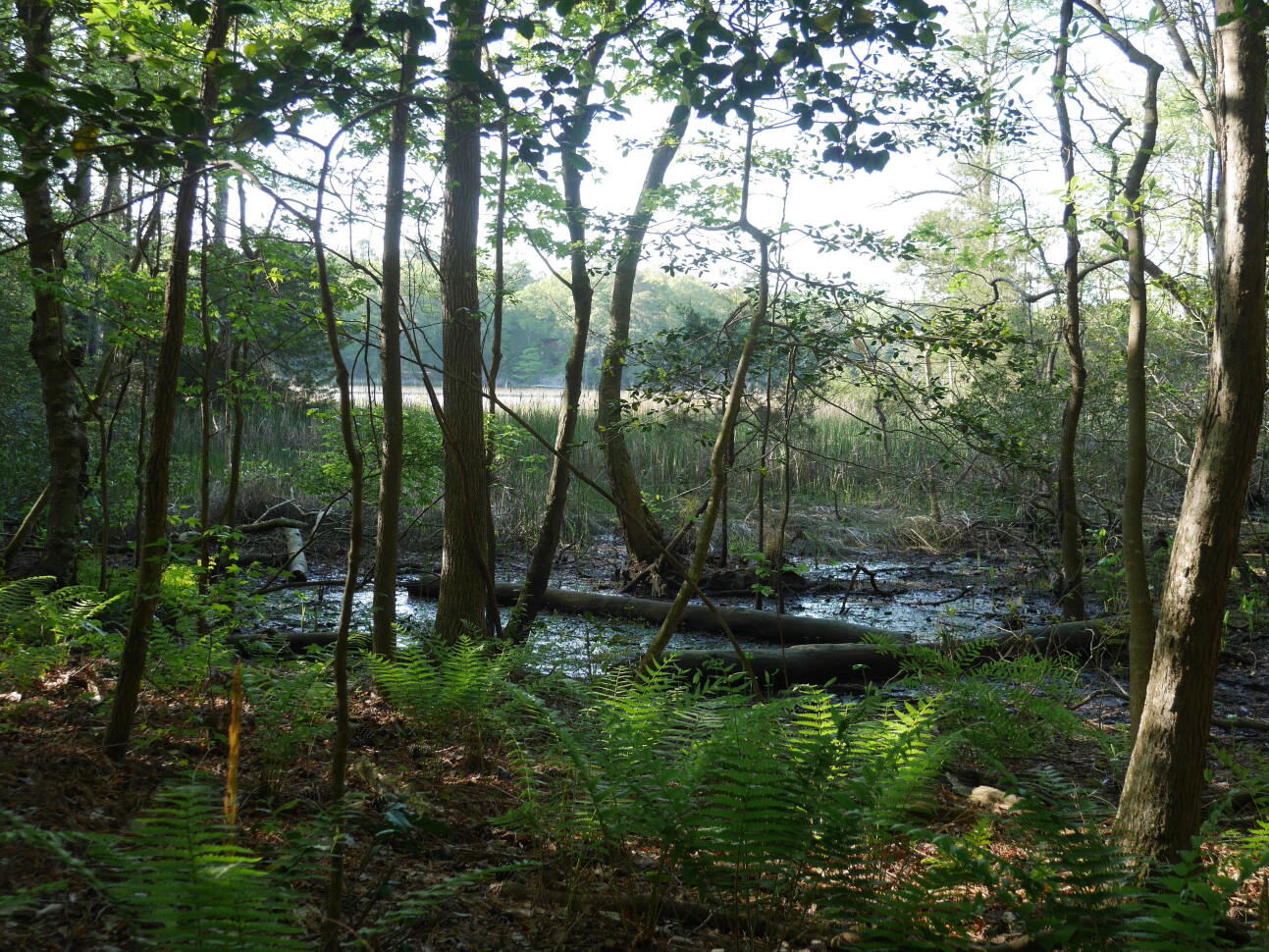Fern Seep is located on Occohannock Creek where the creek’s brackish salinity continues to freshen as it bears north towards its origin close to the Virginia Tech Extension office in Painter. Seeps are an unusual hydrological feature that support a variety of ferns and other water-loving species. The seeps attract plant life that thrives in moist, shady conditions, such as ferns including christmas fern (Polystichum acrostichoides), sensitive fern (Onoclea sensibilis), cinnamon fern (Osmundrastrum cinnamomeum) and Virginia chain fern (Anchistea virginica). Populations of narrow-leaved cattail (Typha angustifolia), switch grass (Panicum virgatum) and broad-leaved arrowhead (Sagittaria latifolia) show where the water is fresher. At the downstream borders of the seep, the creek’s brackish waters support a shoreline marsh consisting primarily of big cordgrass (Spartina cynosuroides).
The covering maritime forest is mostly made up of loblolly pine (Pinus taeda) and yellow poplar (Liriodendron tulipifera) with smaller numbers of black gum (Nyssa sylvatica), sweetgum (Liquidambar styraciflua) and red maple (Acer rubrum). The understory features American holly (Ilex opaca) with lesser numbers of flowering dogwood (Cornus florida). A bald eagle (Haliaeetus leucocephalus) family inhabits the property year-round. The chuck-will’s-widow’s (Caprimulgus carolinensis) crepuscular vocalizations and the raucous calls of laughing gulls (Larus atricilla) are true indicators that spring is here.

Water that emerges at the surface without a perceptible current is called a seep, which differentiates this unusual geologic formation from a spring. Unlike sea level fens, seeps occur in woodlands and are not tidal. Surface soil type varies with location along the seep from a rich humus of decaying leaf litter from the tree canopy, to a spongy peat bog characterized by sphagnum moss supported by less decomposed organic soil.
While deep core soil samples have not been analyzed it is likely that these seeps developed over millennia and result from complex soils where a clay pan or other impermeable layer below the soil stratum forces groundwater to the surface. The resulting water flow results in soils that are seasonally to permanently saturated and may range from sandy or clayey to mucky where the water flows through low lying areas and its overlying rich organic humus. These seeps originate in the hollows of a slightly rolling landscape, and vary from a few feet to maybe 15 feet across. Traversing these delicate areas would be mucky going, you’d sink in a foot or so in many areas.
The seep became officially known as Fern Seep after we moved to the property. I had built my home and retired here, when Accomack County contacted me and said I had to name the dirt road I now lived on so emergency services could find me. So I started to think about the five potential names the form required. Occohannock Marsh Lane, Chuck-Will’s-Widow Way were two of the ideas that I recall but I didn’t like the sound of any of them. A friend was visiting and after I showed him the unusual seeps on my property, he suggested Fern Seep Lane. Certainly it was original if nothing else, so I added it as the fifth choice. Five weeks later I pulled onto my road and noticed a new brown street name sign with “Fern Seep Ln” lettered in white! It was a challenge to get delivery services to acknowledge the new name. I remember one item being returned three times even though I called and left my phone number in case the delivery driver had trouble finding me. It would take 2 years for Google Maps to recognize my new address. Over the years the name has grown on me, and I now find it refreshing.
Living near seeps has helped me grow as a naturalist. I use my field guides, especially Chesapeake Bay, Nature of the Estuary : A Field Guide by Christopher P White and Common Plants of the Mid-Atlantic Coast, a field guide by Gene M Silberhorn, to help me identify various plants around the seeps and elsewhere on my property.

I soon discovered what plants thrived in water with various degrees of salinity. The upwelling water is fresh, or very nearly so (much of our groundwater has at least some salt). As the seep makes its way to the creek proper, the salinity increases, as can be found by tasting the water. The salinity in the seep and the creek beyond also varies depending on the amount of recent rainfall. As I got to know my property’s habitat, I was able to identify where plants thrived based on the salinity of the standing water. In the photos you can see ferns upstream, along with Arrow arum (Peltandra virginica) and narrow-leaved cattail (Typha augustifolio). These plants prefer a lower saline environment, while the more brackish marsh nearer the creek is dominated by the more salt tolerant Spartina cynoseroides.
Photographs by Peter Fisher

